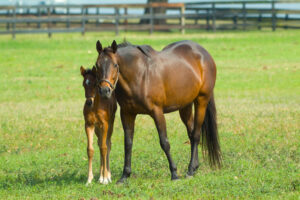In the business of thoroughbred breeding and buying, making informed, strategic decisions is key to achieving success. Whether you’re an aspiring breeder or an experienced investor, understanding and applying OPTIMAL Mating Analysis can significantly enhance your outcomes.
This guide breaks down the steps involved in OPTIMAL Mating Analysis, providing actionable insights and examples to help you breed superior racehorses and make profitable investments.

What is OPTIMAL Mating Analysis?
OPTIMAL Mating Analysis is a systematic approach designed to maximize the genetic potential of offspring by selecting the most compatible mating pairs. By combining the best genetic traits from both the sire and the dam, this method aims to produce superior racehorses.
For thoroughbred breeders and investors, OPTIMAL Mating is crucial. It not only improves genetic quality and enhances performance but also increases profitability in the competitive racing world.
Step 1: Identify the Running Numbers in the 3rd Generation
Running Numbers (1, 2, 3, 4, 5) are identifiers assigned to female families known for producing top runners. Ensuring these numbers are present in the third generation of the pedigree can significantly boost a foal’s racing potential.
For instance, if your mare belongs to a family with Running Number 1, pairing her with a stallion whose pedigree also includes Running Number 1 increases the likelihood of producing a top performer. Make sure to have at least four Running Numbers from the specified list in the third generation.
Step 2: Identify the Sire Numbers in the 3rd Generation
Sire Numbers (3, 8, 9, 11, 12, 13, 14) highlight female families that consistently produce the best sires. Incorporating these numbers in the third generation helps ensure strong sire line influences.
For example, a mare from a family with Sire Number 11 paired with a stallion from a family with Sire Number 12 can result in a foal with robust genetic potential. Aim to include at least one Sire Number from the list in the third generation.
Step 3: Calculate the Outcross Percentage Formulation
The Outcross Percentage measures the ratio of unique names to duplicated names within the fifth, sixth, and seventh generations. Maintaining genetic diversity reduces the risk of inbreeding and associated health problems.
For instance, a pedigree with 70% outcross percentage indicates sufficient genetic diversity. To achieve this, count the unique names and divide by the total number of ancestors in these generations. A minimum of 70% outcross percentage is recommended.
Step 4: Calculate the Duplication Count Comparison
This step involves comparing the number of duplicated ancestors on the sire’s side to the dam’s side up to the seventh generation. A balanced duplication count ensures an even genetic contribution from both sides.
For example, if the sire’s side has 34 duplications and the dam’s side has 33, this near-perfect balance (34/33) is ideal. Strive for a balanced ratio with a maximum variance of 10 (e.g., 34/44).
Step 5: Calculate the Second-Generation Balance
Evaluating the degree of balance in line breeding from the second generation is crucial. Balanced genetic contributions from grandparents lead to more stable and robust offspring.
For instance, a value close to zero, such as 3, indicates balanced line breeding, whereas a higher value, like 17, suggests imbalance. The acceptable limit for second-generation balance is 16 or less.
Step 6: Calculate the Grand Sire/Grand Dam Pair Percentages
This step measures the genetic influence of the grandsires and granddams. Balanced contributions from grandsires and granddams promote hybrid vigor and genetic stability.
For example, a pair percentage close to zero (+2% or -2%) indicates balanced genetic contributions, while a higher percentage (+26%) shows stronger influence from one side. Aim for a percentage close to zero for optimal results, with maximum limits at +17% or -17%.
Step 7: Calculate the Gender-balanced Linebreeding Comparison
Ensuring equal contributions from male and female ancestors is essential. Balancing male and female traits reduces the risk of inherited weaknesses and promotes hybrid vigor.
For example, if your pedigree shows an equal number of male and female progeny among inbred names, you are on the right track. Strive for an equal number of male and female contributions in the pedigree, with a variance of 2 maximum.

Benefits of Using OPTIMAL Mating Analysis
Using OPTIMAL Mating Analysis offers several benefits:
- Improved Genetic Quality: Enhances the genetic makeup of the resulting foal.
- Better Performance: Foals produced through OPTIMAL Mating are more likely to excel on the racetrack.
- Increased Profitability: Superior racehorses command higher prices at sales and generate more winnings.
Examples of Successful OPTIMAL Matings
Animal Kingdom: Designed using a balanced OPTIMAL Mating approach, Animal Kingdom won the 2011 G1 Kentucky Derby and the 2013 G1 Dubai World Cup.
Mor Spirit: Designed through careful OPTIMAL Mating analysis, Mor Spirit won multiple graded stakes races, including the 2017 G1 Met Mile.
Drill: Known for his speed, Drill’s G1-winning success on the track is a testament to the effectiveness of OPTIMAL Mating Analysis.
Common Mistakes to Avoid by Using OPTIMAL Mating
- Ignoring Key Genetic Traits: Overlooking important genetic details can lead to poor breeding and buying decisions.
- Relying Solely on Manual Analysis: Without advanced software, critical insights may be missed.
- Failing to Balance Gender Contributions: Over-relying on one gender’s traits can result in genetic imbalances.
- Neglecting Outcross Percentages: Failing to maintain genetic diversity can lead to inbreeding problems.
Getting Started with OPTIMAL Mating Analysis
To get started with OPTIMAL Mating Analysis, follow these steps:
- Gather Pedigree Data: Collect detailed pedigree information for both the sire and dam.
- Use Breeding Software: Employ advanced breeding software to analyze pedigrees and calculate key metrics.
- Consult Experts: Work with experienced pedigree analysts and bloodstock agents to refine your breeding and buying decisions.
By following these steps and avoiding common mistakes, thoroughbred breeders and investors can make informed, strategic decisions to enhance their breeding and investment outcomes. Implementing OPTIMAL Mating Analysis will help you produce better racehorses, maximize profits and achieve greater success in the competitive business of thoroughbred racing.
Start today by analyzing your matings and purchase prospects, applying these principles and watching your breeding and racing programs flourish. The journey to breeding or buying superior racehorses begins with informed decisions and strategic planning. Happy breeding and buying!







Recent Comments